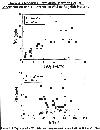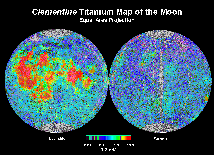NEEP602 Course Notes (Fall 1997)
Resources from Space
Lecture #13: It's only a gassy Moon!
Title: Resources of the Moon: Solar Wind/Cosmic Ray Derived
Visuals:
Slides from Apollo 17
Notes:
- Polar H2O as ice: Clementine photos "put a human face" on the long held knowledge that there are permanently shadowed areas above and below about 70o latitude on the Moon, documenting that the floor of a large basin at the south pole is currently permanently shadowed. Other sensors gave data consistent with, but not proof of, the presence of water ice in this shadowed area
Clementine photo of lunar south pole
PRO- o Theory indicates that if water and a few other volatiles were released some would precipitate in permanently shadowed areas (Watson, 1961, and Arnold, 1979).
- o Permanently shadowed areas exist near the poles.
- o Clementine photographic and radar observations of the South Pole are consistent with the presence of water ice (Nozette, et al, 1996).
CON- o Apollo sample measurements show no definitive evidence of indigenous or solar proton-induced water, although theory would predict that some small quantity of solar proton-induce water should form continuously. The work of Epstein and Taylor (1973) on Deuterium and 18O relationships indicates that no water in lunar samples other than terrestrial water contamination and solar wind hydrogen reaction with the soils.
- o Steady state flux of impacts would release and cause some or all water precipitated in permanently shadowed areas to be ionized and thermally accelerated to escape velocities.
- o Sputtering of ice by charged particles, within the isotropic particle environment of the tail of the Earth's magnetosphere, may cause water loss unless mixing of ice and regolith is rapid enough to offer protection (Arnold, 1979).
- o Radar investigations from Earth-based radio telescopes suggest that rough surfaces may have given the ice-like returns seen by the Clementine bistatic radar experiment (Stacy, et al, 1997).
Solar Wind Volatiles from the regolith
- What are the Solar Wind Volatiles?
- Hydrogen (96%)
- Helium (4%)
- Nitrogen
- Carbon
- Noble Gases (Kr, Xe, Ar)
- Helium (4%)
- The solar wind is the product of fusion reactions in the sun.
The structure of the solar wind in the vicinity of the Earth and Moon is profoundly affected by the Earth's magnetic field.
| Structure of the Solar Wind in the vicinity of the Earth and Moon | |
| Relative Solar Wind exposure for the near side and far side of the Moon |
Hydrogen and helium are the principal components of the solar wind.
 |
Composition of the Solar Wind |
 |
Applications of Lunar Volatiles |
Because of the Moon's roughly spherical shape and its monthly passage through the magnetic tail of the Earth, the net flux of solar wind particles on the lunar surface varies significant with latitude and longitude.- Nearside: Relative flux varies from less than 10% near the poles, to
about 30% at 0 Lat and 0 Long, to over 80% near the 90W and 90E.
- Farside: over 90% between 30N and 30S, dropping off to less than 10% near the poles.
- Penetration of solar particles into mineral and glass particles at
the surface of the regolith is less than 1um, however, over billions of
years of impact induced overturn of the regolith, volatiles become mixed
throughout.
- Any discussions of quantities of lunar volatiles must be tempered by the knowledge that the activities associated with sampling, bagging, and handling of samples on the lunar surface, with handling, splitting, and distribution on Earth, and with handling and processing in the laboratories of investigators probably results in a loss of volatiles to varing degrees from the samples. That the volatiles can be released in this way may be demonstrated by the apparent gas mobilization of the light mantle deposit (avalanche) in the Valley of Tarus-Littrow. None the less, the measured quantities of solar wind volatiles in the Apollo samples must re regarded as minimum values.
Based on the measured concentrations in lunar samples and extrapolations
across the Moon's surface, a rough inventory of lunar volatiles in the upper
3m of the lunar surface can be made.
| Inventory of Lunar Volatiles in first three meters of regolith (note log scale). | |
| Inventory of Lunar Volatiles relative to the production of one tonne of helium-3 |
More specific data on helium relationships:
 Measured Helium content in lunar samples by mission
Measured Helium content in lunar samples by mission Variations in solar wind volatile concentrations by as much as a factor of two have been measured as a function of depth in the regolith in three, 2 to 3 meter drill cores (Apollos 15, 16, and 17). These variations appear to be random and the result of varying maturity of superposed ejecta blankets from which the regolith has been constructed and, in the case of Apollo 17, possible zones of increased abundance of high titanium pyroclastic material.
The process of "gardening" the regolith by repeated impacts of micrometeorites clearly results in the release of some implanted volatiles, but, none the less, there is an increase in concentrations with maturity as measured by decreasing grain size.
A strong correlation exists between helium content and TiO2 (ilmenite - FeTiO3) content, and there may be an increase in concentration with increased maturity as measured by the increased reduction of iron in the regolith to iron metal over time.
| Correlation of Helium content with TiO2 and maturity (Taylor, 1973) | |
| Correlation of Helium Content with TiO2 (and mare vs. highland soils) |
The correlation of helium-3 with the product of TiO2 content
and maturity, however, is very strong, at least for the samples returned
so far. (Taylor, 1993)
 Correlation of Helium content with (TiO2)x(maturity) (Taylor,
1973) "
Correlation of Helium content with (TiO2)x(maturity) (Taylor,
1973) "
Remote sensing from Earth and from the Clementine orbits can be used to
give an approximate distribution of titanium in lunar surface materials
and thus a rough indication of helium distribution, although the maturity
of the soils would need to be over-laid on this distribution to give a better
approximation.
| Distribution of lunar TiO2 as observed by the Clementine mission | |
| Distribution of TiO2 as observed by Johnson, et al, (1991) from Earth-based observations |
The maria whose regoliths are of greatest current interest as a source of solar wind volatiles, such as 3He for fusion power, are those that are oldest and most titanium-rich. Such maria appear to be most abundant in the vicinity of Tranquillitatis. In fact, there are indications that mare eruptions over time may have been roughly concentric to this region and contained less and less titanium on the average.
 |
Titanium content of soils in Mare Tranquillitatis (after Cameron, 1992). |
 |
Estimated helium resource base in Mare Tranquillitatis (after Cameron, 1992). |
Titanium-rich pyroclastic deposits, such as those on the southwestern rim
of Serenitatis, also may be of interest as a source of solar wind volatiles.
Their regolith should be much more easily mined due to the absence of significant
hard rock, may be more easily processed due to their glassy and fine-grained
nature, and they may be a source of several metal and halogen by-products.
Hydrogen, water, oxygen:
Hydrogen does not appear to vary with Ti abundance in the lunar soil and in mature lunar soils, ranges from about 106 ppm to about 17 ppm with a mean value of 46 +/- 22 ppm (Fegley and Swindle, 1993).
Hydrogen in the lunar soil, in concert with the oxygen in the various minerals, is roughly equivalent to 0.5 liter of water per cubic meter or, to a depth of about two meters, about 106 gallons per square mile.
About 90% of the solar wind hydrogen, a significan portion of which combines with oxygen in the silicates and oxides to form water, can be released from lunar soil by simple heating to about 800o C (Pepin, et al, 1970).
Text:
- Evaluation
of the Regolith of Mare Tranquillitatis as a Source of Volatile Elements
(first few pages)
Helium Resources of Mare Tranquillitatis -- Cameron (1992), pp. 16-38
Dark Mantle Material as a Source of Helium (Cameron)
Questions:
1. Discuss the argument for and against the existence of water ice in the permanently shadowed polar regions of the moon, including comparisons with the other, relatively cold terrestrial planets, i.e., Mercury, Earth, and Mars.
2. What are the considerations that must be taken into account if one were to calculate the modern day steady state concentration of 3He in the upper one centimeter of the lunar regolith?
3. How are estimates made of titanium distribution on the Moon using remotely sensed spectral data from the Earth and from the Clementine spacecraft sensors? (Consider starting with: Clementine and Johnson, 1991))
References:
Arnold, J.R., 1979, Ice on the Moon, Journal of Geophysical Research, v 84, 5659-5668.
Cameron, E.N., 1988, Dark Mantle Material as a Source of Helium, unpublished memorandum to G.L. Kulcinski, WCSAR-TR-AR3-8810-3.
Cameron, E.N., 1992, Helium Resouces of Mare Tranquillitatis, Technical Report, WCSAR-TR-AR3-9207-1.
Cameron, E.N., 1993, Evaluation of the Regolith of Mare Tranquillitatis as a Source of Volatile Elements , Technical Report, WCSAR-TR-AR3-9301-1
Fegley, B., Jr., and Swindle, T.D., 1993, Lurar Volatiles: Implications for Lunar Resource Utilization, in Lewis, J., Matthews, M.S., and Guerrieri, M.L., 1993, Editors,Resources of Near-Earth Space, University of Arizona Press.
Heiken, G., et al, 1991, Lunar Source Book, Cambridge University Press, Cambridge, 736p.
Johnson, J.R., et al, 1991, Journal of Geophysical Research, v 96(E3), 18861.
Lewis, J., Matthews, M.S., and Guerrieri, M.L., 1993, Editors,Resources of Near-Earth Space, University of Arizona Press.
Nozette, S. et al, 1996, The Clementine Bistatic Radar Experiment, Science, v 274, 1495-1498.
Pepin, R.O.,et al, 1970, Rare gases ihn Apollo 11 lunar material, Proceedings of the Apollo 11 Lunar Science Conference, 1443-1454.
Stacy, N.J.S., et al, 1997, Arecibo Radar Mapping of the Lunar Poles: a Search for Ice Deposits, Science, v 276, 1527-1530.
Taylor, L.A., 1993, Evidence of Helium-3 on the Moon: Model Assumptions and Abundances, Proceedings of the Second Wisconsin Symposium on Helium-3 and Fusion Power, WCSAR-TR-AR3-9307-3, 49-56.
Watson, K., et al, 1975, The Behavior of Volatiles on the Lunar Surface, The Moon, v 13, 121.
 |
|
University of Wisconsin Fusion Technology Institute · 439 Engineering Research Building · 1500 Engineering Drive · Madison WI 53706-1609 · Telephone: (608) 263-2352 · Fax: (608) 263-4499 · Email: fti@engr.wisc.edu |
Copyright © 2003 The Board of
Regents of the University of Wisconsin System.
For feedback or accessibility issues, contact
web@fti.neep.wisc.edu.
|
 Origin of the Solar Wind
Origin of the Solar Wind



 Solar Wind Volatiles: Depth Profiles
Solar Wind Volatiles: Depth Profiles Distribution of Helium by Grain
Size in an Apollo 11 soil
Distribution of Helium by Grain
Size in an Apollo 11 soil


